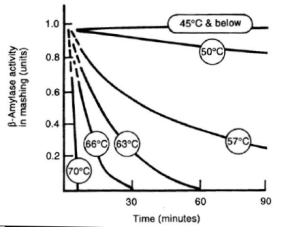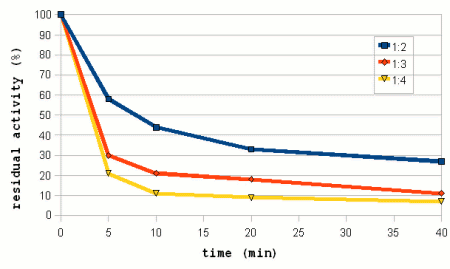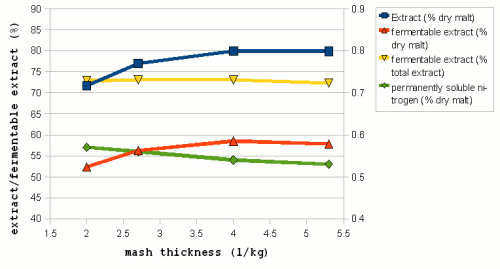In the past I haven't paid much attention to mash thickness other than swearing at it when the wort is running too slow for the recirculation pump. But typically I use about 3.0 litres per kg of grain.
Recently however I read about how a thicker mash slows down the rate at which mash enzymes (especially beta amylase) are destroyed by heat.
Beta amylase is an important enzyme if you're aiming to produce a highly fermentable wort for a crisp, dry beer.
Unfortunately it's a delicate beast - in a typical 66ºc mash its half-life is (at best) only about 7 mins:
 [TU Vienna]
[TU Vienna]
Kai Troester ('braukaiser') says: "The concentration of the mash (water to grist ratio) can have a significant impact on the mash performance".
He offers the following two charts:


The first chart [Kunze, 2007] suggests that thickening the mash from 3 to 2 litres per kg doubles the half-life of β-amylase, from three to seven minutes (at 65ºc).
The second chart [Briggs, 2004] reveals that there may be a small price to pay however, as the same increase in mash thickness reduces the total sugar extraction from about 78% to 72%.
Make of that what you will - but for the time being I have increased my mash thickness to about 2.3 litres per kg.
Surprisingly, this doesn't yet seem to have given me any stuck mashes (that's jinxed it...)
Recently however I read about how a thicker mash slows down the rate at which mash enzymes (especially beta amylase) are destroyed by heat.
Beta amylase is an important enzyme if you're aiming to produce a highly fermentable wort for a crisp, dry beer.
Unfortunately it's a delicate beast - in a typical 66ºc mash its half-life is (at best) only about 7 mins:

Kai Troester ('braukaiser') says: "The concentration of the mash (water to grist ratio) can have a significant impact on the mash performance".
He offers the following two charts:
β-amylase, 65ºc mash


The first chart [Kunze, 2007] suggests that thickening the mash from 3 to 2 litres per kg doubles the half-life of β-amylase, from three to seven minutes (at 65ºc).
The second chart [Briggs, 2004] reveals that there may be a small price to pay however, as the same increase in mash thickness reduces the total sugar extraction from about 78% to 72%.
Make of that what you will - but for the time being I have increased my mash thickness to about 2.3 litres per kg.
Surprisingly, this doesn't yet seem to have given me any stuck mashes (that's jinxed it...)
Last edited:



